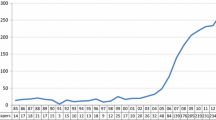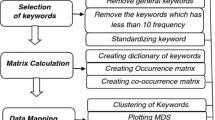Abstract
In this paper, co-word analysis is used to analyze the evolvement in stem cell field. Articles in the stem cell journals are downloaded from PubMed for analysis. Terms selection is one of the most important steps in co-word analysis, so the useless and the general subject headings are removed firstly, and then the major subject headings and minor subject headings are weighted respectively. Then, improved information entropy is exploited to select the subject headings with the experts consulting. Hierarchical cluster analysis is used to cluster the subject headings and the strategic diagram is formed to analyze the evolutionary trends in the stem cell field.



Similar content being viewed by others
References
Bangrae, L., & Yong-il, J. (2008). Mapping Korea’s national R&D domain of robot technology by using the co-word analysis. Scientometrics, 77(1), 3–19.
Bauin, S., Michelet, B., Schweighoffer, M. G., & Vermeulin, P. (1991). Using bibliometrics in strategic analysis: “Understanding chemical reactions” at the CNRS. Scientometrics, 22(1), 113–137.
Callon, M., Courtial, J., & Laville, F. (1991). Co-word analysis as a tool for describing the network of interactions between basic and technological research: The case of polymer chemistry. Scientometrics, 22(1), 155–205.
Callon, M., Courtial, J. P., Turner, W. A., & Bauin, S. (1983). From translations to problematic networks: An introduction to co-word analysis. Social Science Information, 22(2), 191–235.
Callon, M., Law, J., & Rip, A. (1986). Mapping the dynamics of science and technology: Sociology of science in the real world. London: Macmillan.
Courtial, J. P. (1986). Mapping the dynamics of science and technology: Technical issues and developments in methodology (pp. 189–210). London: The Macmillan Press.
Courtial, J. P., & Sigogneau, A. (2009). How to use scientific and technological information to reveal strategic technologies. International Journal of Technology Management, 10(1), 31–44.
Fabian, M., Mathäus, D., Fradkin, D., & Etienne, J. (2008). Anticipating annotations and emerging trends in biomedical literature. Proceeding of the 14th ACM SIGKDD international conference on knowledge discovery and data mining. NY, USA: ACM New York.
Gray, R. M. (1990). Entropy and information theory (pp. 35–53). New York: Springer Verlag.
Law, J., Bauin, S., Courtial, J. P., & Whittaker, J. (1988). Policy and the mapping of scientific change: A co-word analysis of research into environmental acidification. Scientometrics, 14(3), 251–264.
Leydesdorff, L. (2005). Similarity measures, author cocitation analysis, and information theory. Journal of the American Society for Information Science and Technology, 56(7), 769–772.
Qin, H. (1999). Knowledge discovery through co-word analysis. Library Trends, 48(1), 133–159.
Tan, P. N., Steinbach, M., & Kumar, V. (2006). Introduction to data mining (pp. 35–89). Boston: Pearson Addison Wesley.
Xavier, P. (2005). Co-word analysis revisited: Modeling co-word clusters in terms of graph theory. Proceeding or ISSI, 2, 662–663.
Ying, J. (2006). A co-word analysis of bibliometrics in 1995 2004. Journal of the China Society for Scientific and Technical Information, 25(4), 503–512.
Zhao, Y., & Karypis, G. (2002). Evaluation of hierarchical clustering algorithms for document datasets (pp. P515–P524). Virginia, USA: CIKM’02, McLean.
Author information
Authors and Affiliations
Corresponding author
Rights and permissions
About this article
Cite this article
An, X.Y., Wu, Q.Q. Co-word analysis of the trends in stem cells field based on subject heading weighting. Scientometrics 88, 133–144 (2011). https://doi.org/10.1007/s11192-011-0374-1
Received:
Published:
Issue Date:
DOI: https://doi.org/10.1007/s11192-011-0374-1




